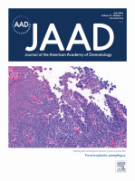Dermatologic side effects of thalidomide in patients with multiple myeloma - 29/08/11
Abstract |
Background: Thalidomide, an antiangiogenic agent, was approved by the Food and Drug Administration in 1998 for the treatment of erythema nodosum leprosum. Although its teratogenic and neurologic side effects are well known, its dermatologic side effects continue to be defined. Objective: We report the dermatologic side effects in 87 patients with multiple myeloma enrolled in a comparative, open-label, clinical trial treated with thalidomide alone (50 patients) or thalidomide and dexamethasone (37 patients). Method: We reviewed the records of all patients enrolled in the clinical trial. The frequency, type, severity, and time of onset of all skin eruptions that were temporally related to thalidomide treatment were recorded. Results: Minor to moderate skin eruptions were noted in 46% of patients taking thalidomide alone and in 43% of those taking thalidomide and dexamethasone. These included morbilliform, seborrheic, maculopapular, or nonspecific dermatitis. Severe skin reactions (exfoliative erythroderma, erythema multiforme, and toxic epidermal necrolysis) that required hospitalization and withdrawal of thalidomide developed in 3 patients receiving thalidomide and dexamethasone. Conclusion: The prevalence of dermatologic side effects of thalidomide appear to be higher than previously reported. Although in most patients they were minor, in a few patients they were quite severe, particularly when given in conjunction with dexamethasone for newly diagnosed myeloma. Further studies are needed to verify the extent of the interaction between thalidomide and dexamethasone in this group of patients. (J Am Acad Dermatol 2003;48:548-52.)
Le texte complet de cet article est disponible en PDF.Plan
| Funding sources: Supported in part by grants CA 85818 and CA 62242, National Cancer Institute. Dr Rajkumar is a Leukemia and Lymphoma Society of America Translational Research Awardee and is also supported by the Goldman Philanthropic Partnerships, Lake City, Ill, and by Celgene Corporation, Warren, NJ, which provided support for the clinical trial. |
|
| Conflict of interest: None identified. |
|
| Reprint requests: Rokea A. El-Azhary, MD, Department of Dermatology, Mayo Clinic, 200 First St SW, Rochester, MN 55905. |
|
| 0190-9622/2003/$30.00 + 0 |
Vol 48 - N° 4
P. 548-552 - avril 2003 Retour au numéroBienvenue sur EM-consulte, la référence des professionnels de santé.
L’accès au texte intégral de cet article nécessite un abonnement.
Déjà abonné à cette revue ?

